«previous pageGENERAL DESIGN CATEGORY
Honor Award
Observation Balloon Preview Park Orange County Great Park,
Irvine, CA
WORKSHOPWEST Ken Smith Landscape Architect, New York, NY and Irvine, CA
client: Orange County Great Park Corporation
Project Statement and Narrative
Known regionally as "The Great Park," this 1,347 acre project will become the heart of future districts for living, commerce, and life-long learning on the former El Toro Marine Air Station in Orange County, California.
This long-term project will take many years to build and grow. Part of its development plan is a 27-acre Preview Park that serves as a visitor center, observation area and prototyping area for elements and features being designed for the Great Park. In Summer 2007 the first phase of the Preview Park opened with a large orange helium filled observation balloon. Other facilities were added in summer of 2008, and more features are planned. Anchored by an orange observation balloon that rises up to a 500-foot height for a commanding view, the Preview Park introduces several prototypes for the orange groves, stonework, and plantings that will eventually fill the entire park.
The Preview Park is being actively programmed with concerts, dances, workshops and other special events to build regional support and to give neighbors a voice in the park's design process. Visible from nearby Interstate 5, the balloon rises 500 feet into the air and can carry up to 30 persons in its gondola. Here, park visitors can survey the park site, and as construction activity accelerates, they can watch the process of the park's development unfold. A nearby temporary visitor center provides exhibits and interpretation of the park's design. The Preview Park is being developed with both temporary and permanent features. Prototypes of proposed park elements include park lighting, seating and other furnishings. Recycled airstrip concrete has been used in the landscape design. A bio-swale is being prototyped, as well as low water turf, heritage citrus plantings and native shade trees. An organic agriculture program is underway. A graphic timeline is a prototype of a much more extensive feature planned for the park. An historic hanger is being used for events, which include summer concerts and dances, a winter ice rink and a planned lecture series.
From the start, we have sought to build a connection between sustainable design and healthful, active living. When Central Park was built at the heart of Manhattan in the mid-19th century, Olmsted's pastoral plan responded to the social and cultural conditions of the time, including the need for passive relaxation and strolling for citizens who worked at demanding physical labor six days a week. Today, most Americans work in sedentary jobs and, especially in places like Orange County, very rarely walk anywhere. By creating a regional attraction and a pedestrian-scale park, we hope to immerse people in many different kinds of ecological microclimates and in cultural venues such as museums, a farmers market, and a historic timeline, and we hope to create opportunities to raise questions about the connections between global, regional and personal health.
One of the major design ideas, the 2.5-mile canyon feature, came from an experience I had visiting San Diego's Balboa Park during the competition overview. Balboa Park was one of the suggested regional sites for entrants to visit. I went there on a hot day and stumbled into a small canyon filled with palm trees and green plants along its walls. It was so much cooler and quieter there; it seemed like a completely different place. Much of this project is about natural connections. A wildlife corridor will be established to link critical travel corridors between the Santa Ana Mountains and the Laguna coastal hills. A formerly buried stream will be day-lighted with floodplain areas reestablished.
The master plan emphasizes long term sustainability with energy production and conservation, recycling, native and xeric plantings, neighborhood connections, community gardens, park-once-spend-the-day transit, and education programs. Orange groves will be planted on former field areas. One of the Great Park's most dramatic cultural landscape remnants is the two-mile long former airstrip that will be retained as an open corridor, military memorial and pedestrian promenade. Cutting at an angle across the site, the airstrip recalls the grand Elm Promenade in Central Park. Also like Central Park, we sited many of the attractions along the edges to preserve the park's core as more quiet and passive.
Project Resources
Team Lead
WORKSHOPWEST Ken Smith Landscape Architect
Collaborative Design Team
Mia Lehrer + Associates
Design Administration
Gafcon, Inc.
Support Team
Fuscoe Engineering
Buro Happold
Wallace Labs
Green Shield Ecology
Aquatic Design Group
D.D. Pagano, Inc. Irrigation Consultants
Dudek & Associates
Lawson and Associates
LSA Associates
TEN Arquitectos
Featured Products
Balloon
Aerophile
Scaffold Shade Structures
Safway Services, Inc.
Glue Laminated Light Poles
Laminated Wood Systems, Inc.
Water Ballast Barriers
Yodock Wall Company, Inc.
Pavement Paint
Pervo Paint Company
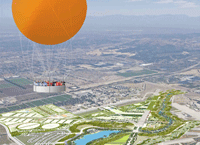
Birds Eye View: Orange County Great Park (Montage: WORKSHOPWEST Ken Smith Landscape Architect)
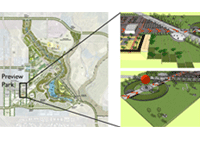
Orange County Great Park Master Plan with Preview Park Location (Montage: WORKSHOPWEST Ken Smith Landscape Architect)
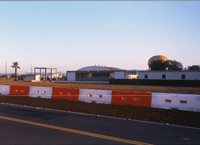
View of Preview Park entry drive. Painted paving graphics provide way finding and the perimeter edges are defined with orange and white water-ballast-barrier hedges. (Photo: Tom Lamb)

View of temporary parking lot. The site improvements in this area minimize permanent alterations to the historic tarmac by using paint graphics and boxed trees. Dark sky cobra head lights have been adapted using tall poles of glue-laminated wood. Wood is used throughout the Preview Park. (Photo: Tom Lamb)
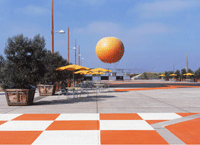
View of axial space between historic hanger 224 and observation balloon. This space is framed by boxed Olive trees and café tables with umbrellas. During the summer, public dances are organized every Friday evening in this area. (Photo: Tom Lamb)

View of over-scaled north arrow, which is designed to be viewed from a height of 500-feet. The use of large-scale graphics and axial features in the preview park landscape are designed to give orientation to park visitors from the balloon. (Photo: Tom Lamb)
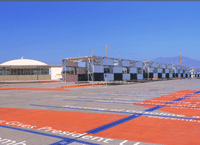
View of timeline. This segment of the park’s future timelines addresses the history of the decade of the 1940’s. This painted timeline prototype was developed by history professors from the University of California, Irvine. (Photo: Tom Lamb)

View of earthwork ring at the observation balloon. The 12-foot high berm edits out views of the park until the gondola rises, providing a dramatic unveiling of the site. Temporary shade structures are fabricated out of construction scaffolding and shad fabric. (Photo: Tom Lamb)
"Truly exceptional. Adopting the graphic language of an airfield in a fresh, contemporary way is absolutely the most dramatic thing that could be done and a brilliant political move."
— 2009 Professional Awards Jury

View of prototype bio-swale. The bio-swale is planted with riparian natives and its linear form is reinforced with a double allee of California Sycamore trees. Permeable aggregate and recycled concrete are used to emphasize sustainability. (Photo: Tom Lamb)
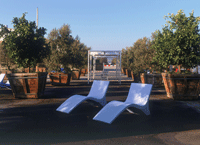
View sitting area set in a grove of boxed Citrus and Olive trees. Lounge chairs and small shade pavilions with chess tables are being prototyped in this area. (Photo: Tom Lamb)
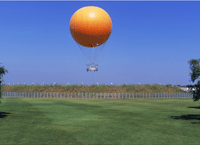
View of balloon rising above perimeter berm. In the foreground is an event lawn, which also serves as a picnic ground, planted with scattered Jacaranda trees. Jacaranda trees are part of the heritage plantings on the former Maine base. (Photo: Tom Lamb)
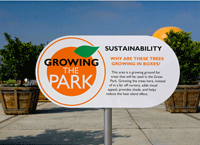
Interpretive signage is an integral part of the Preview Park. The signage is intended to introduce park visitors to sustainability features in the park and explain why the park’s design is different from traditional parks. (Photo: Tom Lamb)
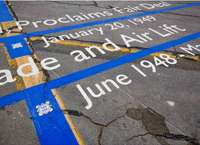
Detail of timeline. The new paint graphics overlay historic airstrip markings. The future timeline will run the length of a taxiway that is to be preserved. The timeline will address the military, agriculture, ecological and social and economic context of the site’s history. (Photo: Tom Lamb)

Detail of recycled runway concrete which is used to stabilize the end slopes of the perimeter berm. Approximately 600-acres of runway paving will be recycle for reuse as architectural and landscape features, road base, earthwork fill and wetland infiltration. (Photo: Tom Lamb)
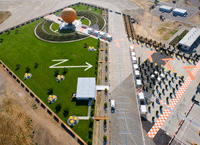
Aerial view of Preview Park. (Photo: Tom Lamb)
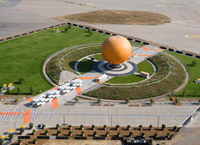
Aerial view of Preview Park. (Photo: Tom Lamb)



